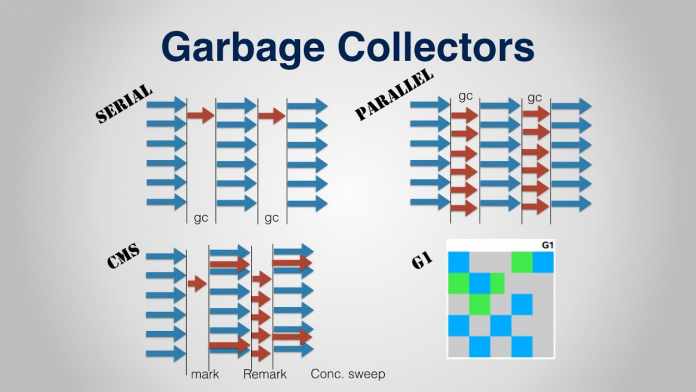In programming, we face several coding problems, such as the Java Garbage Collection. We will guide you to every single detail about Java Garbage Collection and how it performs.
Table of Contents
Java Garbage Collection in Simple Terms
Java Garbage Collection is a whole process of storage management. When you write codes in the Java platform, it compiles all the code into a single program to run on the specific device.
When java complainer runs those codes, some additional junk codes produce. Most of these junk codes doesn’t require for the program. Java Garbage Collection system finds those unused junk codes and frees up the program space.
What is Java Programming Language?
Just as our people have the language to speak or express their thoughts, so do computers and terminology. Java considers as a high-level computer programming language. It connects the computer through the program.
There are also variations in programming languages such as Functional Programming, Object-Oriented Programming, etc. Java gets recognition as the pure object-oriented computer programming language. It only works with objects and classes, but the Java 6.0 version offers functional programming. Java is both a programming language and a unique platform.
How does Java Works?
In Java, the code doesn’t directly convert to machine code. First, the source code compiles, and the byte code generates to create a type of file. This .class file is then interpreted by JVM and converted into machine code.
Eclipse IDE, Netbeans, IntelliJ IDEA are the most widely used Java IDE (Integrated Development Environment).
What is Java Garbage Collection?
Java garbage collectors work on the virtual machine to clean up the codes don’t require any more. The application removes those codes unused for an extended period. It’s an automatic removal process.
Java programming language setting is a modern and realistic programming language. Programmers can easily create objects using the Java programming language. They never have to think about extra memory usage. This is because the Java Garbage Collector automatically removes all unused programming code. This helps the Java programming language to run faster. It allows you to solve all kinds of problems.
When you initially launch a standard java application, the program automatically creates some objects. These objects don’t require use. If you look at one the coding of a java program closely, you will understand it correctly.
Getting back to the code, we can see in the wake of performing one cycle in the following emphasis.
In the end, we will begin getting a ton of trash, and memory will utilize for objects.
This is the place where the program comes in.
In Java, the board’s memory deals with the trash specialist; however, in different dialects such as C, you have to remember the executives yourself utilizing capacities, for example, and.
Programmed memory the executive’s plans, for example, trash assortment keeps the software engineer less stressed over memory the board issues, so he can zero in additional on building up the applications he needs to create.
Garbage collection heap generations –
Naturally, Java is created into heaps—this heap dividends into three different categories or three generations.
- The new generation
- Old Generation
- Extra Old Generation
The new generation also has three different sub-division. All the garbage is first stored in the new generation folder. After it’s for specific times, it is transferred to the old Generation category. And finally, it moved permanently to the extra old generation. In the additional ancient era, garbage was of almost no value in use.
The garbage collector has to do primary operations, marking, and unwrapping. The first agenda garbage collector finds all the junk files and codes and clears the space. It keeps the storage clean.
The same process repeats every time someone starts a Java garbage collector.
It works without anyone else. You can “propose” that it works. However, that is about it.
GC is a daemon string that begins at your JVM and closures when your JVM closes (JVM stops if no more daemon strings exist).
It runs out of sight and produces results when/if necessary. The JVM chooses when it is running, and you can “demand” it with System.gc ().
In any case, I should refer to the fact that you shouldn’t compose your code to rely upon the GC to run (finalizers in Java dislike destructors in C ++). In general, individuals will depend intensely on GC and afterward forget about it, which is a no-no and prompts memory spills and elusive bugs.
What you can rely on is that before you get the java.lang.OutOfMemoryError, the GC took decisive action and put forth a valiant effort.
How does the garbage collector detect garbage?
There is a misconception among many people that the Java Garbage Collection cleans up dead objects. But in reality, the Java Garbage Collection does the exact opposite. It treats all types of code as garbage, except for the currently used coding.
Any item on the pile that has not been checked is trash, as it isn’t open from some other article in the article chart.
In the Java virtual machine, all information is composed, which implies the JVM can recognize references from other information. The capacity to recognize references from additional information is very nearly a necessity for an inevitable trash assortment.
The trash specialist crosses the pile, stack, and relentless pool, searching for references. When in doubt, every one of these items is checked. The stamped objects are then checked for joins, and the predefined objects, thus, are limited.
On the off chance that there are no connections left that are not being followed, you can be confident that all articles that are not labeled are not, at this point, accessible and can be erased.
The essential type of trash assortment called the imprint and-clear city worker.
Note that the Java standard doesn’t need a trash specialist. The JVM standard usage additionally neglects free memory.
There should be a hundred answers here, yet maybe none of them are simple – there are many convoluted approaches to clarify it :). I’ll check it out, so you can see it before this inquiry is set apart as a copy.
- It takes things that it “needs,” you know, as a noticeable window or a functioning string. There is a very much characterized rundown of these things in more unpredictable answers.
- This makes everything on this list that these significant focuses can be gotten to.
- It eliminates everything else.
How to disable the Java Garbage Collection?
I’m afraid you cannot disable the garbage collector. But there is an option that will help you to keep aside the problem.
But if you are willing to disable the Java garbage collection, I would like to share this isn’t an issue. You should not bother about this.
Some people assume weakening the event listeners will disable the Java garbage collector. But this isn’t true.
As3 becomes garbage when it loses all of its reference with other codes.
How Does It Work Java Garbage Collection? (Complete)
Java garbage collection works automatically. For that, you have to meet specific JVM requirements. There are many JVMs available in the market. But, in my personal experience, the Oracle hotspot is the best solution. It beats all of its competitors comprehensively when it comes to garbage collection. You can say some other options as well.
Most of the garbage collectors optimize and can use for various purposes. All the garbage collectors work in the same way. First, they will go after all marked objects and then delete other garbages. in this process; you can free up a massive amount of storage. This process also ensures no additional garbage will create. They blocked all the future trash to keep your program smooth. This process will help to reduce the amount of storage in your electric device.
In hotspot, garbages sort their time of existence. This structure’s logic is to go after recent garbage first and keep old debris later on.
The Sorting is Segregated in Various Parts:
New Generation: All the newly created garbage comes into the new generation category. These codes are subdivided into different types. One deleted immediately once they are found. Another class called Eden keeps the garbage for further scrutiny. The whole new garbage collection system is called tiny garbage collection performance.
Old Generation: garbage has existed for a long time and falls under this category. The new generation data there for a while converts it into the old generation category. This is one of the major garbage collection shuffles.
While performing the collection period, the program collects all the unused data and keeps it in one place.
When does the Java Garbage Collection?
The garbage collector is not thread-safe, so it generally won’t work while your code is running. However, there is one exceptional case where this is not the case.
The keyword new will invoke the garbage collector if it runs out of memory.
You can run this code to observe this behavior:
var vec:Vector.<*> = new Vector.<*>(9001);
for (;;) {
vec[0] = new Vector.<*>(9001);
vec = vec[0];
}
Memory usage will quickly jump to the maximum (1GB for me) and then hold until the timeout is out.
Plenty of acceptable answers are available. But I think some of the critical aspects haven’t been covered yet.
- The Flash player actualizes two sorts of trash assortment. One is reference checking, where Flash keeps a tally of approaching references to each protest and realizes that the item can be deallocated when the total arrives at zero. however, the community, in general, has no approaching references).
- As indicated by the spec, any trash assortment can occur whenever. Likewise, there is no assurance that GCs times. This will continue as before between Flash player adaptations. stages, or even programs. Thus, it isn’t precious to know anything about how GCs work since you cannot get to know how comprehensively your insight is appropriate.
- Leaving aside the last point, as a rule, the imprint mark is rare and works in specific situations. I am mindful of some player/OS setups where the sign/clear can run each N seconds or when the player has surpassed P% of the complete accessible memory; however that was quite a while past, and the subtleties will be changed. Interestingly, GCs reference tallying can happen now and again — in any event between outlines. I don’t think I’ve seen them indicated all the more frequently. However, that doesn’t mean it can’t occur (at any rate in specific circumstances).
Final Words of Java Garbage Collection:
Now you have a clear understanding of Java Garbage Collection. How does it work, and what is it? The article tries to explain. How to get the best out of a java garbage collector. You can also learn how you can keep your storage. Also, free from all these coding junks.
We try to cover all the aspects of the Java garbage collector. If we miss any important point, please comment and share your thoughts. Happy reading……..








